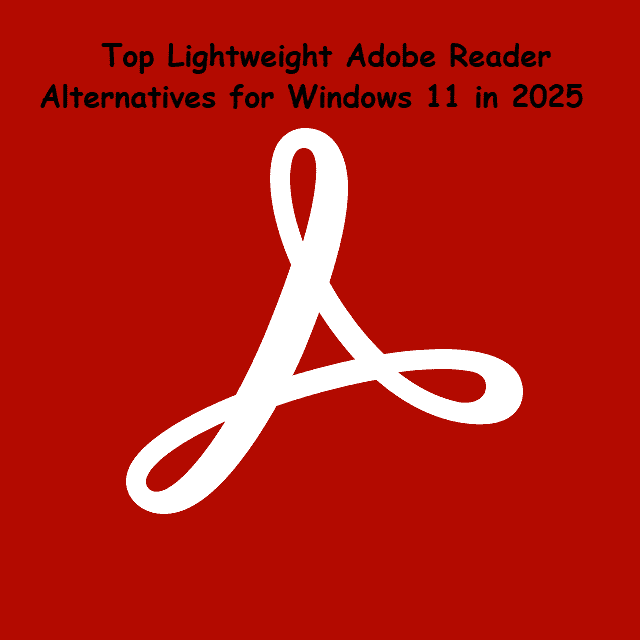PDF files have become the standard for sharing and viewing documents across platforms. That makes PDF readers essential tools for both casual and professional users. Adobe Reader has long been the go-to choice. However, it is no longer the only option; nor necessarily the best one for everyone. With the arrival of Windows 11, users are prioritizing speed, simplicity, and system efficiency more than ever before.
This blog post explores the best lightweight Adobe Reader alternatives for Windows 11 that deliver the core functionality users need without draining system resources.
Why People Are Looking Beyond Adobe Reader
Adobe Reader is undoubtedly a powerful PDF tool. However, it comes with a few common drawbacks:
- High resource usage: It is known to consume considerable CPU and memory on older or low-spec PCs.
- Long startup time: The app can be slow to launch. That can be frustrating when you just want to open a simple document.
- Unwanted extras: Many users feel overwhelmed by Adobe’s added features like cloud integration, e-signature tools, and marketing popups. However, those are not always necessary for basic PDF reading.
- Frequent updates and prompts: Regular update notifications and ads for Adobe’s paid products can be intrusive.
Because of these issues, many users are seeking alternatives that are faster, lighter, and more focused on everyday tasks like viewing, printing, and basic annotations.
The Need for Lightweight PDF Viewers on Windows 11
Windows 11 with its sleek design and tighter system requirements has prompted users to optimize their devices for better performance. Lightweight apps are no longer just a preference they are a necessity for:
- Maintaining system responsiveness
- Saving battery life on laptops
- Running smoothly on low-end or older devices
Lightweight PDF readers fulfill essential needs. Lightweight PDF readers open files quickly and display content accurately. In addition, they offer enough tools without bogging down your system.
If you are a student reviewing notes, a professional scanning contracts, or a casual user reading eBooks then there is a better and faster way than Adobe Reader. In the next section, we will explore some of the best alternatives that strike the right balance between performance and features.
What Makes a PDF Reader Lightweight and Efficient?
Not all PDF readers are created equal. Some come packed with features you may never use. Some others focus on delivering the essentials with speed and simplicity. As users upgrade to Windows 11, there is a growing demand for applications that align with the OS’s modern performance standards—fast, clean, and efficient.
But what exactly makes a PDF reader “lightweight”? It is not just about the size of the installer or the lack of bells and whistles. A truly lightweight PDF reader strikes a balance between performance, functionality, and user experience. Let us explore the key characteristics that define a lightweight and efficient PDF reader.
-
RAM and CPU Usage: Why It Matters
Every application you open takes up a portion of your computer’s memory (RAM) and processing power (CPU). If an app uses too much of either, it can lead to:
- Slowdowns or lag, when multiple programs are open
- Shortened battery life on laptops
- Overheating or fan noise on older devices
- Delayed responsiveness when switching between apps
Adobe Reader is a powerful tool. However, it is known for being resource-heavy. It can spike CPU usage even during simple tasks like scrolling through a document or printing a page. This is mainly due to the background processes and bundled features like cloud sync, plugin loading, and update checks.
In contrast, a lightweight PDF reader is designed to run with minimal impact on system resources. For example:
- SumatraPDF typically uses less than 20MB of RAM when idle.
- Slim PDF loads in under a second and barely touches CPU usage unless interacting with large documents.
This difference is important on Windows 11 devices with limited hardware, like budget laptops, tablets, or older desktops. A lightweight reader ensures your system stays snappy and responsive even when multitasking.
-
Startup Time and User Interface
Time is precious. Nobody wants to wait 10-15 seconds to open a one-page document. Adobe Reader’s startup time is often delayed due to its attempts to load various components, like:
- Adobe Cloud integration
- Digital signature services
- Auto-update modules
- Promotional banners for Adobe’s paid tools
These background processes contribute to longer load times and a cluttered user experience.
Lightweight alternatives, on the other hand, focus on speed and simplicity:
- They launch in under 2 seconds on most systems.
- They offer a minimalist interface often free of distractions.
- The toolbar usually includes the essentials: zoom, navigation, print, and basic annotation tools.
For Windows 11 users, this aligns perfectly with the OS’s modern and minimal design language. A clean interface ensures less time hunting through menus and more time getting work done.
-
Essential vs. Bloat Features
A major reason people switch from Adobe Reader is feature overload. It offers a comprehensive suite of tools that includes cloud storage, editing, sharing, and digital signatures. Most of the users find these features unnecessary for daily tasks.
Here is a comparison to illustrate:
| Essential Features | Bloat Features |
| Open and view PDFs | Integration with Adobe Cloud |
| Zoom and search | E-signature and enterprise tools |
| Page rotation | Frequent update prompts |
| Basic highlighting | Access to Adobe subscription services |
| Print and share | Embedded browser support |
Lightweight PDF readers remove the clutter by focusing only on core functionalities like:
- Fast file rendering
- Smooth scrolling
- Text selection and copy
- Basic annotations like highlights or sticky notes
By eliminating bloat, these readers consume less disk space and have fewer background processes. That ultimately improves system performance.
Some tools like MuPDF go a step further and offer a text-only interface. It is ideal for those who prefer a completely distraction-free reading environment.
Thoughts on Lightweight Efficiency
To summarize, a lightweight and efficient PDF reader should:
- Use minimal memory and processing power
- Launch quickly and respond instantly
- Feature a clean, uncluttered interface
- Focus on essential tools that most users actually need
With the modern demands of Windows 11, there is never been a better time to ditch bloated software and switch to something faster and smarter. In the following section, we will explore the top contenders that check all these boxes.
Top Adobe Reader Alternatives in 2025
Adobe Reader is a heavyweight when it comes to PDF viewing. However, many users now opt for lighter, faster, and less resource-hungry alternatives. If you want to open large documents quickly, avoid software bloat, or simply try a fresh user interface, here are the top Adobe Reader alternatives for Windows 11 in 2025.
Each of these tools brings something unique to the table. They bring such as from minimalistic PDF viewing to full-fledged editing capabilities. That too brings all without slowing down your system.
-
Foxit Reader – A Power-Packed Adobe Alternative
Short Description:
Foxit Reader is one of the most popular Adobe Reader alternatives. It is known for its robust set of features and fast performance. Foxit Reader is a favorite among professionals and students alike.
Key Features:
- Smooth tabbed interface for multitasking
- Annotate, highlight and comment on PDFs
- Secure reading with anti-malware protection
- Form filling and digital signatures
Pros:
- Fast and responsive
- Loaded with tools even in the free version
- Multi-language support
Cons:
- Includes optional bloatware during installation
- Some tools are only available in the Pro version
Supported Platforms: Windows, macOS, Linux, Android, iOS
Official Link: Foxit PDF Reader
-
SumatraPDF – Minimalism at Its Best
Short Description:
SumatraPDF is the ultimate choice for users who want a simple, fast PDF reader. It is incredibly lightweight, with no bells and whistles. It is pure, fast PDF viewing.
Key Features:
- Ultra-fast load time
- Supports PDF, ePub, MOBI, CHM, CBZ, and CBR
- Portable version available
Pros:
- Bare minimum system usage
- Portable and open-source
- No installation is needed (portable mode)
Cons:
- No editing or annotation tools
- Not ideal for form-filling or business documents
Supported Platforms: Windows
Official Link: SumatraPDF
-
PDF-XChange Editor – Feature-Rich and Developer-Friendly
Short Description:
PDF-XChange Editor is an advanced PDF viewer and editor. It is designed for users who need more than reading capabilities. It strikes a great balance between power and speed.
Key Features:
- Edit, annotate, and digitally sign PDFs
- Built-in OCR engine for scanned documents
- Multi-tabbed interface
Pros:
- Lots of features even in the free version
- Excellent editing and markup tools
- Customizable UI
Cons:
- Steeper learning curve for beginners
- Watermarks appear on some features unless you upgrade
Supported Platforms: Windows
Official Link: PDF-XChange Editor
-
Slim PDF Reader – Ultra-Compact PDF Viewing
Short Description:
Slim PDF Reader is all about doing one thing right—viewing PDFs. It is one of the smallest desktop PDF readers. It is perfect for basic use on low-end PCs.
Key Features:
- Tiny installer size (~15MB)
- No frills—just open, read, and print PDFs
- Updated UI for modern use
Pros:
- Extremely small footprint
- Quick installation and launch
- Stable performance
Cons:
- No annotation, form filling, or advanced features
- Not suitable for power users
Supported Platforms: Windows, Linux
Official Link: Slim PDF Reader
-
MuPDF – Lightweight and Open-Source Power
Short Description:
MuPDF is a super-compact open-source PDF reader known for its high-quality rendering. It also comes with a scripting engine, making it ideal for developers.
Key Features:
- Clean, fast rendering engine
- Minimal GUI or command-line use
- Supports PDF, XPS, CBZ, EPUB
Pros:
- Excellent for low-resource environments
- Great rendering quality
- Customizable for developers
Cons:
- Very basic interface
- Lacks form-filling or annotation tools
Supported Platforms: Windows, Linux, macOS, Android
Official Link: MuPDF
-
Okular – Open Source with Powerful Annotations
Short Description:
Built for the KDE desktop environment. Okular is a versatile PDF reader that combines functionality with efficiency. It’s perfect for Linux users but also available for Windows.
Key Features:
- Text highlighting and note-taking
- Page bookmarking and metadata support
- Supports PDFs, comics, eBooks, and images
Pros:
- Feature-rich and intuitive
- Excellent support for different file formats
- Open-source and secure
Cons:
- Slightly complex UI for new users
- Windows version requires additional dependencies
Supported Platforms: Linux (native), Windows (via KDE installer)
Official Link: Okular
-
Evince – GNOME’s Lightweight Document Viewer
Short Description:
Evince is the default document viewer for GNOME-based Linux distributions. It is simple and efficient. It is perfect for reading without distractions.
Key Features:
- Basic PDF viewing and text search
- Supports PostScript, DjVu, TIFF, and DVI formats
- Clean UI with essential tools
Pros:
- Lightweight and stable
- Open-source and customizable
- Works well on older systems
Cons:
- Lacks advanced tools like editing or form support
- Windows version is unofficial
Supported Platforms: Linux (official), Windows (unofficial builds)
Official Link: Evince
Adobe Reader Alternatives: The Right Tool for the Right User
If you want raw speed and simplicity then SumatraPDF and Slim PDF Reader are unbeatable. For advanced tools, the PDF-XChange Editor and Foxit Reader lead the pack. Linux users will love Okular and Evince. However, developers may prefer MuPDF for its minimalism and scripting potential.
All these tools are free or offer powerful free versions. That makes them great options if Adobe Reader is no longer meeting your needs.
Feature Comparison Table: Adobe Reader Alternatives (2025)
| PDF Reader | Annotation | Platform Support | Installer Size | Open Source | Form Filling | OCR Support | Editing Tools | Best For |
| Foxit Reader | Yes | Win, macOS, Linux, Mobile | ~100 MB | No | Yes | Yes | Limited (Free) | Feature-Rich Workflows |
| SumatraPDF | No | Windows only | ~5 MB | Yes | No | No | No | Speed & Simplicity |
| PDF-XChange Editor | Yes | Windows only | ~90 MB | No (Freeware) | Yes | Yes | Yes (Some Paid) | Editing & Annotation |
| Slim PDF | No | Windows, Linux | ~15 MB | No | No | No | No | Ultra-Light Use |
| MuPDF | No (basic) | Win, macOS, Linux, Android | ~10 MB | Yes | No | (via scripts) | No | Developers & Custom Use |
| Okular | Yes | Linux (Native), Windows (via KDE) | ~80 MB | Yes | Yes | No | Limited | Power Users on Linux |
| Evince | No | Linux (Official), Windows (Unofficial) | ~25 MB | Yes | No | No | No | Basic Reading on Linux |
Quick Picks for Different User Needs
| Need | Best Option |
| Lightweight & Super Fast | SumatraPDF |
| Best All-Round Features (Free) | Foxit Reader |
| Best Editing + Annotation Tools | PDF-XChange Editor |
| Most Portable & Lightweight Viewer | Slim PDF |
| For Developers & Scripting Lovers | MuPDF |
| Linux Power Users | Okular |
| Simple Linux PDF Viewer | Evince |
Adobe Reader vs. Top Alternatives: Quick Recap
Adobe Reader has long been the industry standard for viewing, printing, and annotating PDF documents. However, many users today are exploring alternatives due to performance concerns, and excessive resource usage. In addition, Adobe Reader has bundled features they seldom use.
While Adobe Reader remains a solid choice for professionals who need advanced features like e-signatures, cloud integration, and complex form support. It is not the most efficient for everyday use on low to mid-range machines.
That is where alternatives shine. Several lightweight, fast, and even open-source PDF readers offer similar functionality without a heavy memory footprint. Depending on your needs, if it is speed, annotation, simplicity, or editing capabilities then there is likely a better fit.
Tabular Format: Quick Comparison of Adobe Reader Alternatives
| Software | Best For | Key Strengths | Why Choose Over Adobe Reader |
| Foxit Reader | Power users & professionals | Rich features, annotation tools, faster than Adobe | Feature-rich but lighter and more responsive |
| SumatraPDF | Speed-focused users | Ultra-light, super fast, portable | Ideal for viewing only; loads instantly |
| PDF-XChange Editor | Annotators & light editors | Free editing, markup tools, OCR support | Strong free toolkit, better UI responsiveness |
| Slim PDF Reader | Low-resource systems | Minimalist, tiny install size (~15 MB) | No bloat, perfect for older PCs or basic needs |
| MuPDF | Developers & advanced users | Scriptable, open-source, fast rendering engine | Highly customizable, minimal interface |
| Okular | Linux users & KDE desktop fans | Annotation, text selection, free/open-source | Powerful Linux-native tool with a modern interface |
| Evince | Basic document viewing on Linux | Clean interface, quick rendering, GNOME-integrated | Lightweight alternative to Okular for simple PDF viewing |
Key Takeaways for Users
- Adobe Reader is still relevant. But it is mostly for feature-heavy corporate workflows.
- Alternatives like SumatraPDF or Slim PDF are ideal for users who prioritize speed and efficiency.
- Need editing or annotation? Try PDF-XChange or Foxit for powerful free features.
- Low on resources or using an older PC? Lightweight viewers are your best bet.
- Many alternatives are free or open-source. In addition, they offer excellent value.
Adobe Reader
Pros:
- Industry standard with wide compatibility.
- Advanced features: digital signature, form filling, cloud sync.
- Regularly updated with security patches.
Cons:
- Heavy on system resources (RAM & CPU usage).
- Slower startup time.
- Often bloated with features not useful for average users.
- Privacy concerns due to Adobe’s telemetry.
Foxit Reader
Pros:
- Fast and efficient performance.
- Rich annotation and form tools.
- More lightweight than Adobe.
- Available across platforms.
Cons:
- The free version includes ads and occasional prompts.
- Some advanced features require a paid upgrade.
SumatraPDF
Pros:
- Ultra-lightweight (under 10MB).
- Portable and open-source.
- Lightning-fast loading.
- Great for basic reading (PDF, EPUB, MOBI, etc.).
Cons:
- No editing or annotation tools.
- Very minimal interface—it may feel too barebones.
PDF-XChange Editor
Pros:
- Powerful annotation and editing tools for free.
- Built-in OCR support.
- Highly customizable interface.
- Excellent performance.
Cons:
- The slight learning curve for beginners.
- Some features are gated behind a license (watermarked in the free version).
Slim PDF
Pros:
- Smallest install size (~15MB).
- Basic but essential viewing tools.
- Great for older or low-spec devices.
Cons:
- No editing or advanced tools.
- No support for complex PDFs or multimedia.
MuPDF
Pros:
- Open-source and scriptable.
- Fast, accurate rendering.
- Extremely lightweight.
Cons:
- Command-line heavy. Not user-friendly for all.
- Limited UI and usability for general users.
Okular (Linux)
Pros:
- Native to KDE desktop, well-integrated.
- Annotation and form support.
- Open-source and regularly maintained.
Cons:
- Linux-centric; Windows build is not as polished.
- KDE dependencies may not suit all Linux environments.
Evince (Linux)
Pros:
- Simple, clean interface.
- Lightweight and fast.
- Great for everyday PDF needs.
Cons:
- Minimal features; lacks advanced tools.
- Only available for Linux.
Conclusion
Final Thoughts: Say Goodbye to Bloatware
Adobe Reader has served users faithfully for decades, but times have changed. If you are on a high-powered machine or an older laptop running Windows 11, lightweight PDF readers offer faster performance, fewer distractions, and more control over your system resources.
Adobe Reader Alternatives offer various benefits. Those range from SumatraPDF’s lightning speed to PDF-XChange Editor’s robust toolset. Today’s alternatives cater to a wide range of needs without bogging down your PC. If you are tired of sluggish startups, unwanted pop-ups, or bloated features you never use, it is time to switch.
Choose Based on What Matters to You
- Need blazing speed and simplicity? → Try SumatraPDF or Slim PDF
- Want annotation and form-filling? → Go for Foxit Reader or PDF-XChange Editor
- Prefer open-source and privacy-first options? → Check out MuPDF, Okular, or Evince
Say goodbye to bulky software and hello to smarter, faster productivity.
Now it is Your Turn!
Which PDF reader do you use—and why?
Share your favorite alternative in the comments below. Let us help others find the perfect fit!
FAQs: Answering Common Reader Questions
- What is the lightest PDF reader for Windows 11?
SumatraPDF is widely considered the lightest PDF reader for Windows 11. It is incredibly small (under 10MB), portable, and fast. It lacks advanced features like annotation or editing. However, it is perfect for users who need a simple, no-frills viewer.
- Are Adobe Reader alternatives safe?
Yes, most reputable alternatives like Foxit Reader, PDF-XChange Editor, SumatraPDF, and Slim PDF are completely safe to use. Always download software from official websites or trusted sources to avoid bundled malware or adware. Open-source options like MuPDF, Okular, and Evince are especially trustworthy.
- Can these lightweight PDF readers handle large files?
Generally, yes. Readers like PDF-XChange Editor and Foxit Reader are optimized to handle large documents efficiently. SumatraPDF also manages large files surprisingly well despite its minimal size. However, performance can vary depending on file complexity (images, forms, multimedia, etc.).
- Do I lose functionality when switching from Adobe Reader?
It depends on what you use Adobe Reader for. Most alternatives cover basic features like viewing, searching, printing, and even annotating PDFs. For specialized needs like e-signatures, cloud sync, or advanced forms, some free tools may fall short. However, paid versions or premium upgrades often fill the gap.







